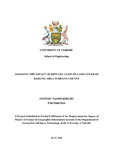Assessing the impact of refugee camp on land cover of Kakuma area Turkana county

View/
Date
2016-07Author
Omwebu, Naomi K
Type
ThesisLanguage
enMetadata
Show full item recordAbstract
According to the United Nations High Commission for Refugees (UNHCR), the number of refugees and internally displaced people has reached its highest point since World War II.By the end of 2015, more than sixty million individuals were forcibly displaced worldwide as a result of persecution, conflict, generalized violence, or human rights violations. Kenya is currently hosting over 600,000 refugees mainly in camps located in semi-arid areas at Kakuma and Dadaab where the main source of fuel is firewood and charcoal. The influx of refugees in these camps for over the last two decades has resulted into an increase in the demand for this natural resource causing a strain on the environment. In order to understand the impact of refugees on theland cover, this study aimed at assessing the land cover dynamics of the area surrounding Kakuma refugee camp. Supervised classification by maximum likelihood algorithm using IDRISI software was employed. A multi-temporal post-classification study using Landsat data for three epochs – year 1987, 2003 and 2015 was performed and the land cover changes quantified. It was evident from this study that as the population of Kakuma refugee camp increased, more vegetated land was being converted to bare ground and built up area. Built up area increased by 3.6%, bare ground increased by 22%, riverine forest decreased 2.9%, while shrubland decreased by 22.7%, from 1987 to 2015. The main cause for these changes was established to be the increase in human activities as a result of harvesting of firewood in order to meet the increasing demands brought about by the influx of refugees. As per the findings of this study, remote sensing has been employed to delineate and quantify the extent of land cover degradation in Kakuma area. The information generated in this study provides critical input for decision-making and demands for urgent land cover management and planning the future sustainably.
Publisher
University of Nairobi
